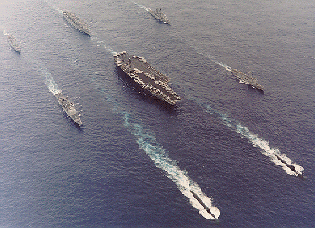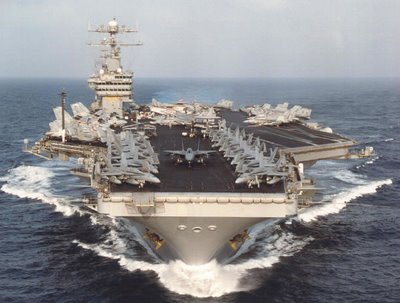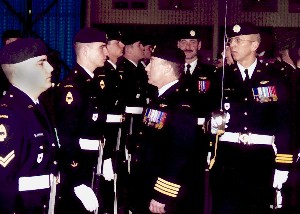
The March to War: Naval build-up in the Persian Gulf and the Eastern Mediterranean
by Mahdi Darius Nazemroaya
Global Research, October 1, 2006
Editor's note
We bring to the attention of our readers, this carefully documented review of the ongoing naval build-up and deployment of coalition forces in the Middle East.
The article examines the geopolitics behind this military deployment and its relationship to "the Battle for Oil".
The structure of military alliances is crucial to an understanding of these war preparations.
The naval deployment is taking place in two distinct theaters: the Persian Gulf and the Eastern Mediterranean.
Both Israel and NATO are slated to play a major role in the US-led war.
The militarization of the Eastern Mediterranean is broadly under the jurisdiction of NATO in liaison with Israel. Directed against Syria, it is conducted under the façade of a UN peace-keeping mission pursuant to UN Security Council Resolution 1701. In this context, the war on Lebanon must be viewed as a stage of a the broader US sponsored military road-map.
The naval armada in the Persian Gulf is largely under US command, with the participation of Canada.
The naval buildup is coordinated with the planned air attacks. The planning of the aerial bombings of Iran started in mid-2004, pursuant to the formulation of CONPLAN 8022 in early 2004. In May 2004, National Security Presidential Directive NSPD 35 entitled Nuclear Weapons Deployment Authorization was issued. While its contents remains classified, the presumption is that NSPD 35 pertains to the deployment of tactical nuclear weapons in the Middle East war theater in compliance with CONPLAN 8022.
These war plans must be taken very seriously.
The World is at the crossroads of the most serious crisis in modern history. The US has embarked on a military adventure, "a long war", which threatens the future of humanity.

~UPDATE~
BOXERESG Begins Maritime Security Operations
Release Date: 11/25/2006 4:05:00 PM
By Mass Communication Specialist Seaman Apprentice Joshua Valcarcel, Commander, U.S. Naval Forces Central Command/Commander, U.S. 5th Fleet Public Affairs
USS Boxer, At Sea (NNS) -- USS Boxer (LHD 4) Expeditionary Strike Group (BOXESG) began maritime security operations near Al Basra Oil Terminal (ABOT) and Khawr Al Amaya Oil Terminal (KAAOT). (MSO) in the North Persian Gulf in support of U.S. 5th Fleet Nov. 21 through 24.
Coalition forces conduct MSO under international maritime conventions to ensure security and safety in international waters so that all commercial shipping can operate freely while transiting the region.
BOXESG has been serving alongside the Afloat Forward Staging Base Ocean 6 patrolling the waters near Terminal (KAAOT). Ocean 6 is the command and control platform responsible for coordinating all MSO activity with coalition forces in the region, focusing on protecting ABOT and KAAOT.
~~~~~~~~~~~~~~~~~~~~~~
 Anbar Picture Grows Clearer, and Bleaker
Anbar Picture Grows Clearer, and BleakerBy Dafna Linzer and Thomas E. Ricks
Washington Post Staff Writers
Tuesday, November 28, 2006; Page A01
The U.S. military is no longer able to defeat a bloody insurgency in western Iraq or counter al-Qaeda's rising popularity there, according to newly disclosed details from a classified Marine Corps intelligence report that set off debate in recent months about the military's mission in Anbar province.
The five-page report -- written by Col. Peter Devlin, a senior and seasoned military intelligence officer with the Marine Expeditionary Force -- is marked secret, for dissemination to U.S. and allied troops in Iraq only. It does not appear to have been made available to Iraqi national forces fighting alongside Americans.
~~~~~~~~~~~~~~~~~~~~~~~~~

DAILY EXPRESS
Unsolved Mystery
by Spencer Ackerman
Only at TNR Online Post date 02.12.05
We all know the resolution to last year's showdown between former counterterrorism czar Richard Clarke and his ex-boss, former National Security Adviser Condoleezza Rice. Clarke accused Rice of woeful inattention to Al Qaeda before September 11, claiming that a December 2000 strategy paper he delivered to her on January 25, 2001, never received the senior-level attention it deserved. Rice accused Clarke of distorting what was in the paper, claiming in a March 22 Washington Post op-ed that it merely offered "several options"--not a "plan"--and that the administration ultimately put together a "comprehensive" strategy "that marshaled all elements of national power to take down" Al Qaeda. Clarke is now a columnist for The New York Times Magazine. Rice is now Secretary of State. It's not hard to grasp who came out on top.
History's verdict, however, is a different matter entirely. The National Security Archive yesterday posted on its website Clarke's January 25, 2001, warning to Rice, along with the December 2000 paper that accompanied it, titled, "Strategy for Eliminating the Threat from the Jihadist Networks of Al Qida: Status and Prospects." These newly declassified documents don't resolve the dispute between Clarke and Rice. Full resolution can only occur when we see how Clarke's paper compares with the strategy Rice described, which was finalized just seven days before September 11 and is known as NSPD-9. NSPD-9 is still classified and will be for many years to come. But the added level of depth provided by the text of "Strategy for Eliminating the Threat," combined with the 9/11 Commission's description of NSPD-9, suggests that Clarke was likely telling the truth--and that Rice probably misled the public about the Bush administration's pre-9/11 counterterrorism policy.
Rice, in her op-ed, described NSPD-9 like this:
Our plan called for military options to attack al Qaeda and Taliban leadership, ground forces and other targets--taking the fight to the enemy where he lived. It focused on the crucial link between al Qaeda and the Taliban. We would attempt to compel the Taliban to stop giving al Qaeda sanctuary--and if it refused, we would have sufficient military options to remove the Taliban regime. The strategy focused on the key role of Pakistan in this effort and the need to get Pakistan to drop its support of the Taliban.
Start with Rice's description of NSPD-9's call for "military options." In January 2001, Clarke suggested to Rice that the new administration consider "overt U.S. military action to destroy al Qida command/control and infrastructure and Taliban military and command assets." This overt action would complement covert action by either Special Forces or anti-Taliban Afghan proxies to "identify and destroy camps or portions of camps run by known terrorists while classes are in session." As the 9/11 Commission concluded in its final report, NSPD-9 "included a section directing Secretary Rumsfeld to 'develop contingency plans' to attack both Al Qaeda and Taliban targets in Afghanistan. The new section did not specifically order planning for the use of ground troops, or clarify how this guidance differed from the existing [Operation] Infinite Resolve plans," which were developed in the Clinton administration. While the declassified NSPD-9 will tell the full story, it's hard to see much difference between what Clarke suggested in January and what the NSC approved in September, as 9/11 Commission member Jamie Gorelick indicated in her questioning of Rice.
Then there's the "crucial link between al Qaeda and the Taliban." Clarke's paper--which incorporated a CIA proposal known as Blue Sky--didn't suggest overthrowing the Taliban. At its most aggressive, it advised the administration to "explore possible efforts to remove the more extreme wing of the Taliban from power" through a mixture of "propaganda and covert action." Presumably, then, at least some rump Taliban force would remain in control of most of Afghanistan. But whether NSPD-9 envisioned, as Rice wrote, "sufficient military options to remove the regime" is uncertain, considering what it appears to have tasked the Pentagon to come up with. Both NSPD-9 (according to the descriptions provided by Rice and the 9/11 Commission) and Clarke's paper suggested aiding the Northern Alliance in its ongoing war against the Taliban. Rice wrote that the administration considered "a modest spring 2001 increase in funding for the Northern Alliance." Clarke, by contrast, suggested "massive support to anti-Taliban groups such as the Northern Alliance." Clarke's proposal was to exhaust the Taliban, though, while Rice suggests NSPD-9's goal was regime change. Whether NSPD-9 devoted significant resources to doing so will only be clear after it is declassified.
Finally, there's the question of Pakistan. In her testimony to the Commission, Rice rightly emphasized the importance of Pakistan to any realistic plan for destroying Al Qaeda in Afghanistan. The closest she came to outlining what was in fact offered by the Bush administration in NSPD-9 was to say that "our new approach to Pakistan combined the use of carrots and sticks to persuade Pakistan to drop its support for the Taliban"; under questioning, she testified that it would "try to unravel this overlapping set of sanctions that were on Pakistan." But Pakistan features heavily in "Strategy for Eliminating the Threat." In fact, the section on Pakistan takes up two pages of a 13-page memo, the heftiest of any of its component parts, and argues for "encouraging Pakistan's distaste for its Taliban adventure." Its range of measures aimed at cleaving Pakistan from the Taliban were broad: from "the blunt instrument of [United Nations Security Council] sanctions" to "moral and practical support" for an International Monetary Fund aid package to helping Pakistan "build up a secular education system that ends rural Pakistan's exclusive reliance on the fundamentalist madrassas."
Again, the release of "Strategy for Eliminating the Threat" doesn't settle the issue of how different it truly is from NSPD-9. What it does suggest is that the differences were not as substantial as Rice suggested in the Post and under questioning.
One thing that Clarke and Rice agree on is that neither "Strategy" nor NSPD-9 would have prevented September 11, even if implemented on the first day the Bush administration took office. But, as Clarke testified to the Commission, had Bush officials--and, for that matter, Clinton officials--implemented Clarke's proposals expeditiously, we could have begun important work to destroy Al Qaeda much earlier than we did. If Rice and her boss want to argue that national security benefited from the eight months it took to get NSPD-9 approved, they can start by declassifying the mysterious document.
Spencer Ackerman , a former associate editor of The New Republic, is a senior correspondent for The American Prospect.

No comments:
Post a Comment